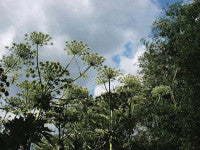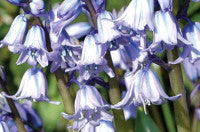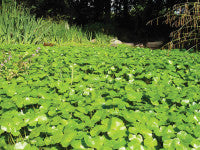Identifying potentially invasive plants
 Invasive non-native species threaten biodiversity in Britain. Often, the environmental damage they cause is irreversible.
Invasive non-native species threaten biodiversity in Britain. Often, the environmental damage they cause is irreversible.
The Invasive Non-Natives Species Framework Strategy for Great Britain (The Strategy) calls for a preventative approach to be adopted vis-à-vis invasive species. This may require potentially invasive, non-native plants to be banned from sale, prohibited from being planted in the wild, or eradicated from known sites in the wild.
A total of 1,867 non-native plant species (excluding marine species) were named in the 2005 audit of non-native species in England, and thousands more non-native plants are available to buy for use in gardens, landscaping and ponds. Yet, invasive non-native plant species represent only a small proportion of our non-native flora. So, for preventative action to be proportionate, determining which species warrant preventative action and which do not is imperative.
Predicting invasiveness cannot be done with complete accuracy, and the potential for currently benign plants to become invasive as the climate changes adds to this challenge.
When attempting to determine a plant's invasive potential, identifying characteristics such as smothering growth-forms and prolific seed production is useful, but not fool-proof, as plants often behave differently when removed from their usual constraints.
Evidence of invasive behaviour in natural and semi-natural habitats elsewhere can also be indicative of potential invasiveness but, given the time lags associated with many plant invasion histories, this is not, in itself, robust either. However, used in combination, and with the added consideration of pathways of introduction and spread within Britain, a broad level of risk can be assigned with some confidence. 
The current mechanism for identifying potentially invasive plants in Britain involves a detailed Risk Assessment process that is both time and resource intensive. This renders it inappropriate to apply to large numbers of species. This project devised, trialled and implemented a rapid screening process designed to be applicable to larger numbers of plants. It is based on the Australian Weed Risk Assessment.
The screening consists of twenty-two questions that relate to current status in the UK, evidence of weed status outside of the UK, undesirable (invasive) traits, reproduction, dispersal mechanisms, and persistence attributes.
The results can be used to help prioritise resources by indicating a shortlist of species for which more detailed assessment is considered imperative and/or prudent and a much longer list for which such assessment is deemed currently unnecessary.
Moves to restrict species highlighted in this study through a ban on sale are not justifiable without further assessment of the risks they pose.
A total of 599 non-native plants of potential invasive concern were assessed, of which:
• 92 are recommended for more detailed risk assessment as a matter of priority (ranked critical)
• 55 are highly recommended for more detailed risk assessment (ranked urgent)
• 72 are recommended for more detailed risk assessment (ranked moderate risk)
• 380 are identified as requiring no further assessment at present (ranked low risk).
It is recommended that all plants screened are reviewed periodically to take account of emerging evidence and information, changes in climate and new horticultural varieties that become available which may, for example, be more frost-hardy than those currently available.
Freshwater and terrestrial plants were included in the study. In light of the differences in invasion histories typical of freshwater and terrestrial systems, these two groups of species were treated differently.

Invasions by non-native species in freshwater habitats tend to take place at a much faster rate than invasions in terrestrial habitats. In comparison, plant invasions in terrestrial habitats are typically quite slow, particularly if they involve woody species and/or highly fragmented habitats.
Due to the speed of invasion in freshwater habitats, and the fact that many non-native invasive plants currently thought to be causing damage to the biodiversity of aquatic systems are ornamentals that have 'escaped over the garden wall', we decided that all commercially available non-native freshwater plants should be included in this study.
The final screening was applied to 368 freshwater plants, over 90% of which are not currently known from the wild in Britain. In future it is recommended that any new aquatic species found to be on sale in Britain should be screened as soon as their existence is discovered.
In addition, produce contaminants ('hitch-hikers') should also be identified and subject to rapid screening. Of the freshwater plants assessed, 33 were ranked Critical (9%); 26 Urgent (7%); 60 Moderate Risk (16%); and 249 Low Risk (68%). Of the terrestrial plants assessed, 59 were ranked Critical (25.5%); 29 Urgent (12.5%); 12 Moderate Risk (5%); and 131 Low Risk (57%). Comprehensive Risk
Assessments have been commissioned by the Non-Native Species Secretariat for 18 of the species screened in this study (at the time of submission): 13 of these were ranked Critical in the present assessment, 1 Urgent, 3 Moderate Risk and 1 Low Risk (giant salvinia Salvinia molesta).
It is recommended that the remaining 201 critical, urgent, and moderate risk ranked species should also be subject to full risk assessments.
With the publication of the screening method, additional aquatic species found to be on sale in Britain, and a wider scope of terrestrial plants, can now be screened by third parties.
As it requires less than thirty minutes to assess each plant, it is hoped that this screening process can be further developed into a tool that proves useful to land managers and the horticultural trades, as well as policy makers.
It is hoped that the Rapid Risk Assessment is developed further if it is to be used more widely by non-native invasive experts, particularly with regard to the weighting of questions and the handling of uncertainty.
Alan Spedding may be contacted by email at: Alan.spedding@btopenworld.com
